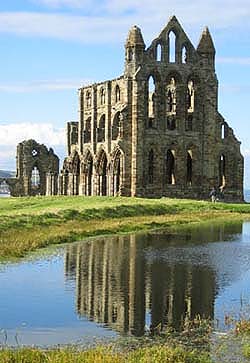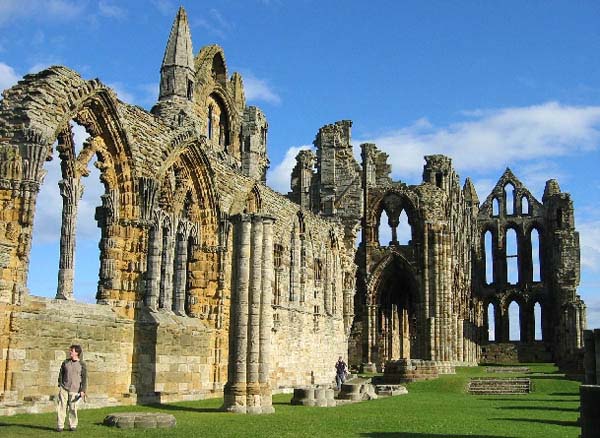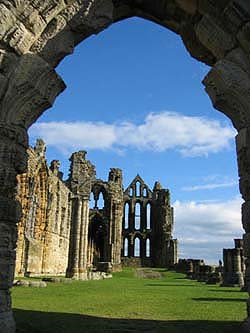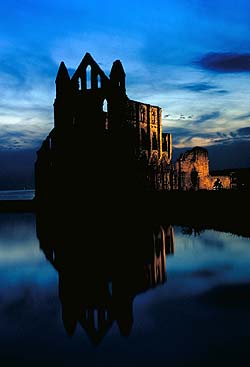Discovering Whitby Abbey
by John Ravenscroft
The magnificent ruins of Whitby Abbey, Yorkshire, are set on a
headland that projects into the North Sea, and they dominate the
town below -- a town that Bram Stoker knew well and used as a
backdrop for parts of his famous Gothic novel,
Dracula.
 There are two ways to approach the Abbey: from
the car park to the south, or from Whitby town itself via 199
winding (and rather steep!) stone steps. Unless you're feeling
particularly energetic, the route from the car park is the best
option. There are two ways to approach the Abbey: from
the car park to the south, or from Whitby town itself via 199
winding (and rather steep!) stone steps. Unless you're feeling
particularly energetic, the route from the car park is the best
option.
Following that path, you'll pass by the Abbey Pond and find
yourself facing an impressive stone façade. This is the
eastern wall of the church choir.
Work probably began on this building in the 1220s, but there was
an earlier, much smaller, church on the site, dating from about
1090. The foundation lines of the older building are still
visible in the grass.
When the monks of Whitby decided to build their new abbey it
seems they wanted to substantially improve upon what had gone
before, and clearly no expense was spared. The result was an
impressive piece of early Gothic architecture with a design
similar to other ambitious constructions of the time, such as the
choirs of Glasgow Cathedral and Rievaulx Abbey, and the transepts
of York Minster.
In the Middle Ages the interior of the choir would have been
richly painted and the windows glazed with colored glass.
According to John Leland, a 16th-century recorder, one of the
stained-glass windows here showed William the Conqueror punishing
the Scots for indulging in a dubious habit -- they were believed
to be cannibals! The elaborate stone carving on the walls is all
that remains of that rich pictorial history now, but it is still
possible to imagine what a glorious sight this building must have
been in its heyday.
Looking down the length of the abbey, past the north and south
transepts and along the nave, you can see the west front, which
was originally as impressive as the façade of the choir.
Much of it collapsed in the late 1700s, and in 1914 it suffered
further damage when a raiding force of German Navy ships shelled
Whitby. There was outrage throughout Britain at the time because
of this needless attack on a civilian target.
Near the nave you can find several tombstones. These were
excavated in the 1920s, and some of them are ancient indeed. They
date back to Anglo-Saxon times, and are remnants of the first
abbey that was erected on this site, founded by the formidable St
Hild in the year 657.
St Hild
St Hild was a Saxon princess -- daughter of Prince Hereric and
sister-in-law to Aethelhere, King of East Anglia -- and she seems
to have been a remarkable character. She was born in 614, and
baptized by the missionary Paulinus, but lived a secular life for
33 years before she felt called upon to renounce the world and
become an abbess, first at the monastery of Hartleypool, and
later at Whitby. The Venerable Bede, the famous 8th-century monk
who wrote The Ecclesiastical History of the English
People, notes that, "she taught the observance of
righteousness, mercy, purity and other virtues, but especially of
peace and charity."

The monastery she founded at Whitby was mixed, housing both
monks and nuns, and under Hild's guidance it became a flourishing
community. Five future bishops were associated with it, as was
the first known English poet, Caedmon.
During Hild's time as abbess, Christianity was spreading
throughout England, but there was conflict between the two
factions responsible for spreading it -- Celtic monks from the
north, and monks influenced by Rome from the south. They may have
shared the same faith, but they disagreed about details such as
clerical dress, the date on which Easter should be celebrated,
and the distinctive monastic hairstyle known as the tonsure. Such
differences may seem unimportant to us, but at the time they were
matters of fierce contention. The tonsure, for example, was not
just a fashion issue. Male slaves in ancient Roman had their
heads shaved to indicate their master's power, and to both Greeks
and Romans the shaved head had long been a symbol of ownership
and slavery.
When monks began to shave their heads to indicate they too were
slaves -- "slaves of Christ" -- the tonsure became an important
sign of holy subservience, but as the Roman clergy gained in
status, many of them abandoned the practice and chose to wear
their hair in the same fashion as members of the ruling classes.
Celtic monks were unhappy about this, feeling that their humility
to Christ should continue to be symbolized through their
hairstyle.
Finally, in 664, a synod was held at Whitby Abbey where
representatives of both sides came to argue their case. After
much heated debate it was decided that all monks would in future
follow the Roman conventions, both in hairstyles and in matters
of the calendar.
The Death of Hild
 When
Abbess Hild died in 680, a nun in the monastery of Hackness,
thirteen miles away, was said to have had a vision of her being
carried aloft by angels. Bede maintains that a messenger who was
sent from Whitby with the sorry news was shocked and confused to
find the monks and nuns at Hackness already mourning her
passing. When
Abbess Hild died in 680, a nun in the monastery of Hackness,
thirteen miles away, was said to have had a vision of her being
carried aloft by angels. Bede maintains that a messenger who was
sent from Whitby with the sorry news was shocked and confused to
find the monks and nuns at Hackness already mourning her
passing.
After her death, Hild was granted sainthood. Her relics, along
with those of King Oswy and King Edwin, attracted many pilgrims,
and the financial donations these pilgrims brought to the abbey
were used to fund further building work.
We know that a certain Princess Aelfled became the next abbess,
but from the mid-8th century the fate of the monastery St Hild
established is uncertain. Any historical records that may once
have existed have been lost, but it seems likely that the
monastery was attacked by Viking raiders in about 867 and all but
destroyed. The ruins the visitor can see today date from long
after the Norman Conquest of 1066.
Around 1070 a Norman soldier called Reinfrid stopped at Whitby
and saw the architectural remains of the previous buildings. Some
years later, having taken holy vows and became a Benedictine
monk, he returned to Whitby with a group of followers and set
about re-establishing the monastic community. Reinfrid was
subsequently killed in an unfortunate accident whilst helping
workmen build a bridge sometime around 1087.
By the year 1220, Whitby Abbey had become one of the wealthiest
monasteries in the country, housing dozens of monks. Much of its
wealth vanished over the next few decades because of the huge
costs of building work. It took about sixty years to complete the
choir and the transepts, and by that time the monastic purse was
empty. In 1320 an inspection of the abbey revealed that it was
deeply in debt, and in 1334 a fundraising campaign was given the
go-ahead by the Archbishop of York. Even so, there are
indications that it took until the late 15th century to complete
the nave.
On the 14th December, 1539 William Davell, the last abbot of
Whitby, gave the abbey to Henry VIII's commissioners under the
Dissolution of the Monasteries Act. Official records show that
there were 22 members of the abbey community at that time, and
the annual income from the monastic estates was £437 -- a
tidy sum for the 1500s.
The Cholmley Family
 Just three months later, the buildings and land
on which the abbey stood were leased to a certain Richard
Cholmley, known as "the great blacke knight of the North" who
later bought them. His son, Francis Cholmley, subsequently made
substantial changes to the old abbot's lodging, and it became
Cholmley House. Just three months later, the buildings and land
on which the abbey stood were leased to a certain Richard
Cholmley, known as "the great blacke knight of the North" who
later bought them. His son, Francis Cholmley, subsequently made
substantial changes to the old abbot's lodging, and it became
Cholmley House.
In the 17th century, the Cholmley family created landscaped
gardens and added a new wing to the house which they used for
entertaining guests. This lost its roof during a violent storm,
was neglected, and fell into decay. The ancient abbey church also
suffered. Its roof was stripped of lead and it was left at the
mercy of the elements, which resulted in two major collapses. The
nave fell in 1762 and the tower crumbled in 1830, leaving the
abbey much as it appears today.
The shells fired by the German navy in WWI further damaged the
west front of the abbey church, and in 1920 the abbey ruins, then
owned by the Strickland family, were handed over to the Ministry
of Works. The ruins were cleared up and the area around the
church was excavated. In 1984 English Heritage took on the care
of the abbey and has made major improvements, including the
creation of an impressive new Visitor's Center in the former
Cholmley House. Here you can discover more about the history of
the site, and see some of the archaeological finds that have
helped bring that history to life. These include an Anglo-Saxon
key, painted glass from the windows, an ancient bone comb and
other intimate artifacts.
My first glimpse of Whitby Abbey was late one evening, under a
full moon. I already knew of the Dracula connection, and it was
easy to imagine Bram Stoker looking up at the ruins on the
headland, and that sight feeding his inspiration. However, there
is far more to this fascinating monument than its fame as a
backdrop to a horror novel. If you get chance to visit, I
strongly urge you to do so.
Abbey Opening Times
1st October - 31st October: 10am - 5pm (Mon Tue Wed Thur Fri Sat Sun)
1st November - 19th March: 10am - 4pm (Mon Thur Fri Sat Sun)
24-26 December and 1st January: Closed
1st April - 31st October: 10am - 5pm (Mon Tue Wed Thur Fri Sat Sun)
1st November - 31st March: 10am - 4pm (Mon Thur Fri Sat Sun)
24-26 December and 1st January: Closed
Related Articles:
- Whitby: Town of Voyagers and Vampires, by Jane Gilbert
- https://www.timetravel-britain.com/articles/towns/whitby.shtml
- Cook's Tour: Exploring "Captain Cook" Country, by Keith Kellett
- https://www.timetravel-britain.com/articles/churches/cook.shtml
More Information:
We regret that we no longer have the resources to maintain up-to-date links and/or hours and pricing details for the various sites and attractions listed on this website. For more information about the location(s) listed above, please use your favorite search engine or visit Wikipedia.
John Ravenscroft is a teacher-turned-writer who lives in Lincolnshire, England. He spends much of his time struggling to write fiction and co-editing Cadenza Magazine. His short stories have won prizes in various literary competitions and been published in numerous magazines, and his work has also been broadcast on the BBC. Visit his website at http://www.johnravenscroft.co.uk.
Article © 2006 John Ravenscroft; photos © Astra Ravenscroft
Bottom photo courtesy of Britainonview.com
| 